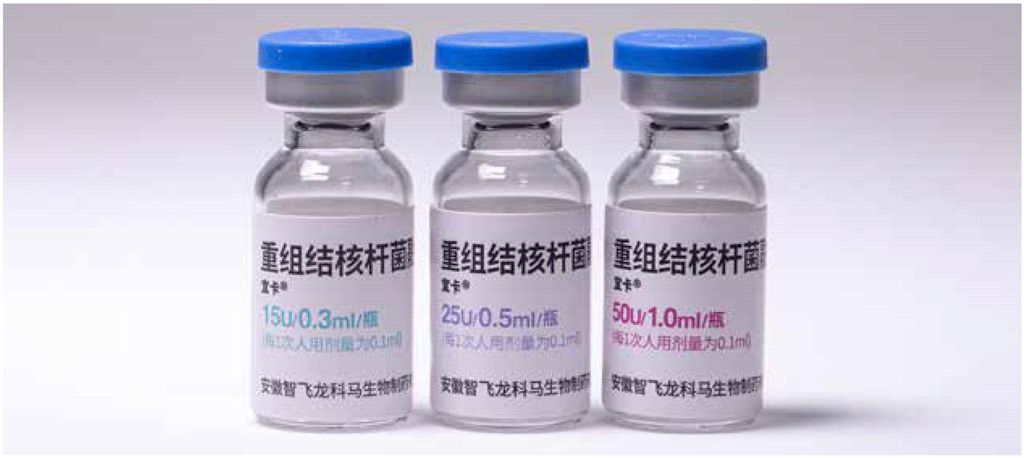كتاب روابط اجتياز لـ 1266
The active ingredient in C-TST (formerly known as the ESAT6-CFP10 test, Anhui Zhifei Longcom, China) is an ESAT-6–CFP-10 fusion recombinant protein expressed in genetically modified E. coli. Each test dose of 0.1 mL contains 5 U of recombinant M. tuberculosis fusion protein, and auxiliary ingredients – disodium hydrogen phosphate, potassium dihydrogen phosphate, sodium chloride, phenol and polysorbate 80 (41).
Fig. 3.3. C-TST vials

Source: Reproduced with permission of Anhui Zhifei Longcom, ©2021. All rights reserved.
The manufacturer recommends administration using the Mantoux method – intradermally on the inner aspect of the forearm below the level of the elbow (cubital fossa). The manufacturer then recommends reading of the reaction at the injection site 48–72 hours after injection. The transverse and longitudinal diameters of both redness and induration should be measured, and the average diameter of the redness or induration should both be recorded (calculated as the sum of the transverse and longitudinal diameters, divided by two). Whichever is the larger (either the redness or the induration) is selected as the result for clinical interpretation. The presence of blistering, necrosis (skin breakdown) or lymphadenitis is recorded and interpreted as a strong positive reaction (41).
Safety
According to the manufacturer’s product insert, seven clinical trials to evaluate safety were completed in China, involving a total of 3854 subjects. These included 861 patients with TB, 443 patients with other non-TB diseases, and 1984 healthy people of whom 361 had received BCG vaccination 11–13 weeks earlier, and 205 had received placebo vaccination at the same time. Most participants received C-TST and TST at the same time; all data related to systemic adverse reactions were collected from subjects who received TST (i.e. with PPDS) at the same time. These studies were included in a recent systematic review (38). In two Phase 2B studies, adverse reactions were more frequent with C-TST than with standard TST (27.8% versus 16.5%, P<0.001). A single study assessed systemic reactions and noted that nine of 144 participants (6.3%) of C-TST developed systemic reactions; these included hypertension and vasculitis. In these studies, C-TST was administered at the same time as TST which makes attribution of systemic adverse events between tests difficult. Data from a phase III trial are awaited.
Pregnancy and lactation
Pregnancy and lactation are not mentioned in the product insert, and no data on C-TST in pregnancy and lactation are available.
Contraindications
Contraindications specific to C-TST, from the product insert, are:
- those aged under 6 months or above 65 years, relative contra-indication, as no data regarding safety or accuracy available in these age ranges; and
- patients with acute infectious diseases (e.g. measles, pertussis, influenza or pneumonia), acute meningitis with ocular involvements, acute otitis media and extensive skin diseases.

 تعليق
تعليق